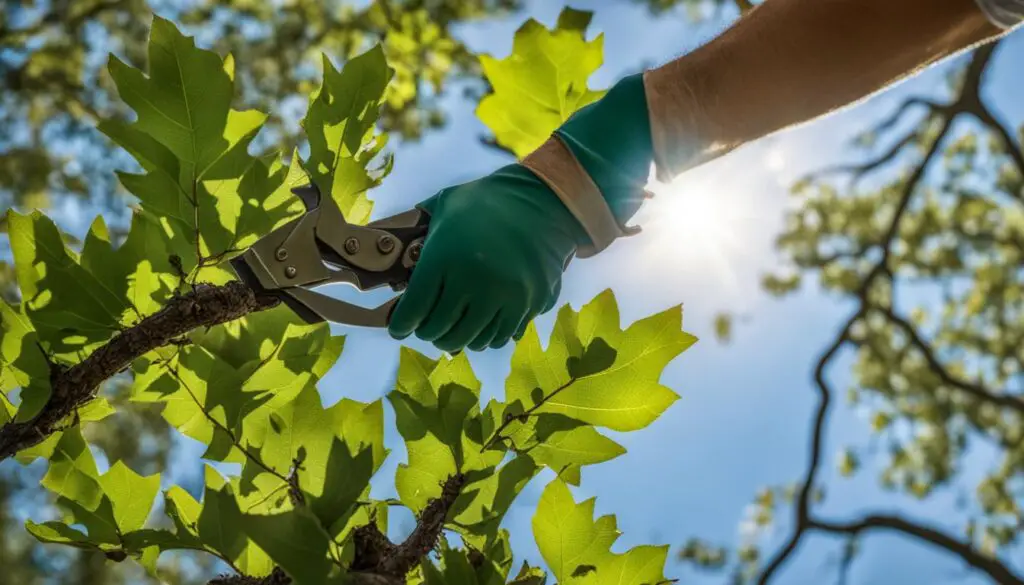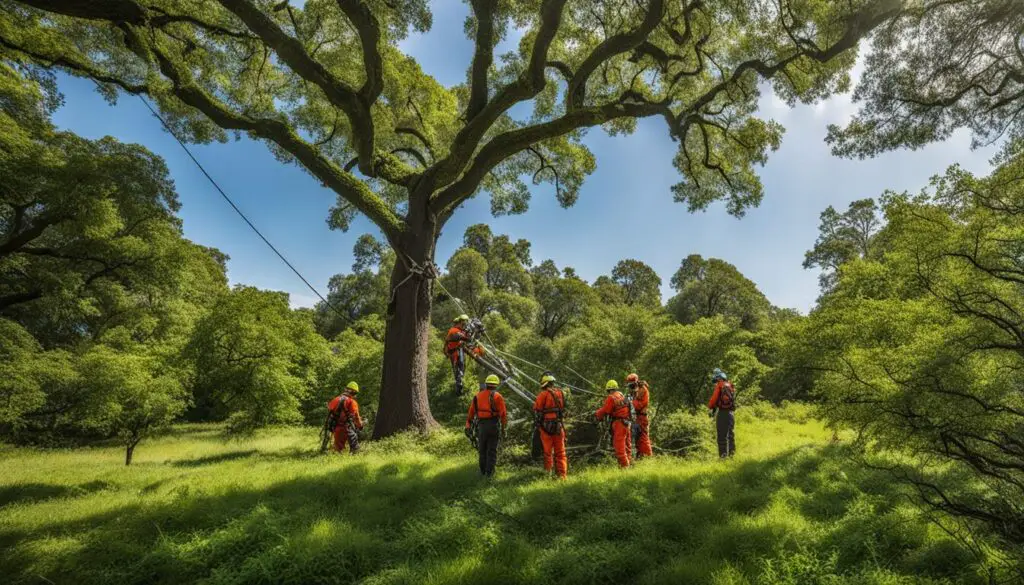Proper pruning of oak trees is essential for their health and vitality. Pruning should be done when trees are dormant, ideally in late winter or early spring before insects that spread oak wilt become active. Oak trees should not be pruned after March 15th to reduce the risk of oak wilt infection. When pruning, it is important to clean and sanitize your pruners, assess the tree before making cuts, and use proper technique to promote proper healing. Thinning branches, removing diseased or damaged branches, and pruning lower branches for easier maintenance are recommended practices for oak tree pruning.
Key Takeaways:
- Trim oak trees when they are dormant, ideally in late winter or early spring.
- Do not prune oak trees after March 15th to reduce the risk of oak wilt infection.
- Clean and sanitize pruners before pruning oak trees.
- Assess the tree before making cuts to promote proper healing.
- Thinning branches, removing diseased or damaged branches, and pruning lower branches are recommended practices for oak tree pruning.
The Basics of Oak Tree Pruning
When it comes to oak tree pruning, following proper technique is crucial for the tree’s health and vitality. It is important to clean and sanitize your pruning tools before starting, as this helps prevent the spread of disease between trees. Assessing the tree before making cuts ensures that you are targeting the right branches for removal.
One key aspect of oak tree pruning is thinning branches. This involves removing branches that cross or touch each other, as well as eliminating acute branch angles. Thinning the branches not only improves the appearance of the tree but also promotes better airflow and reduces the risk of branch breakage.
Another important aspect of oak tree pruning is the removal of diseased or damaged branches. These branches can be a source of infection and can impact the overall health of the tree. By removing them, you help the tree focus its energy on healthy growth.
Pruning lower branches of oak trees can also be beneficial. By doing so, you make maintenance tasks, such as mowing the lawn or applying mulch, easier. Additionally, trimming the lower branches allows sunlight to reach the ground beneath the tree, promoting the growth of grass or other plants.
It’s worth noting that using pruning sealer or similar products on oak trees is not recommended. Oak trees have a natural healing process that is sufficient for sealing off pruning cuts and preventing infection. Applying pruning sealer can actually hinder the tree’s ability to heal properly.
Pruning Tools for Oak Trees
Having the right tools for oak tree pruning is essential for achieving optimal results. Here are some tools that are commonly used:
| Tool | Description |
|---|---|
| Pruning Shears | Perfect for cutting small branches and twigs, these shears are lightweight and easy to handle. |
| Lopping Shears | Designed for cutting thicker branches, lopping shears provide the extra leverage and reach necessary for larger cuts. |
| Pole Pruners | These long-handled pruners allow you to safely reach higher branches without the need for a ladder. Ideal for making clean, precise cuts. |
| Hand Saws | A sturdy hand saw with a sharp blade is helpful when dealing with larger branches. Look for one with a comfortable grip for extended use. |
Remember to always choose sharp and clean tools to minimize damage to the tree and prevent the spread of diseases.
By following the basics of oak tree pruning, you can help ensure the health, vitality, and beauty of your oak trees for years to come.
Best Time for Oak Tree Trimming in Texas
In the vast state of Texas, knowing the best time for oak tree trimming is essential to maintain the health and vitality of these majestic trees. The timing of oak tree trimming in Texas is influenced by various factors, including the specific region, climate, and the tree’s species. To ensure optimal results, it is recommended to consult with a certified arborist who is familiar with the local conditions.
Oak trees in Texas are typically pruned during the fall and winter months, when they are in a dormant state. During this period, the trees are less prone to stress and diseases, making it an ideal time for trimming. Avoiding oak tree trimming during the oak wilt season, which typically spans from February to July, is crucial to prevent the spread of the deadly oak wilt disease.
For oak trees, particularly live oaks, it is best to schedule pruning in late fall or early winter, before they undergo a leaf exchange. The removal of dead and broken branches can be performed at any time, as it promotes overall tree health. However, for the most accurate recommendations and personalized advice, it is advisable to seek the expertise of a certified arborist, who will consider the specific tree species, environmental factors, and the presence of any diseases or pests.

Properly timed and executed oak tree trimming in Texas plays a vital role in maintaining the well-being of these iconic trees. By adhering to the recommended pruning season and consulting with a certified arborist, tree owners can ensure that their oak trees remain vibrant, healthy, and resilient.
Importance of Timing and Technique in Oak Tree Trimming
When it comes to trimming oak trees, timing and technique are of utmost importance. Proper timing ensures that the tree can heal wounds effectively and avoid potential risks, while proper technique promotes healthy growth and prevents damage. Let’s delve into the significance of timing and technique in oak tree trimming.
The Importance of Timing
Trimming oak trees during the dormant season, typically in late winter or early spring, has numerous advantages. This timing allows the tree to heal wounds before the arrival of spring, when disease and insect activity become more prominent. By trimming oak trees during this period, you can:
- Minimize the risk of disease and insect infestation
- Promote proper healing and growth
- Ensure the overall health and vitality of the tree
However, it’s crucial to avoid trimming oak trees during the oak wilt season, which typically occurs from February to July. Oak wilt is a deadly disease spread by pests that prey on fresh pruning cuts. Trimming during this period can increase the risk of infection and harm the tree’s well-being.
The Significance of Technique
Proper technique is vital for successful oak tree trimming. Utilizing the right techniques ensures that the tree can heal properly, minimizes the risk of damage, and supports healthy growth. Here are some key techniques to consider:
- Cutting Close to the Branch Collar: When making cuts, it’s important to trim as close to the branch collar as possible without leaving a stub. The branch collar contains specialized cells that aid in the healing process.
- Avoiding Over-trimming: Over-trimming, which involves removing excessive branches, can be detrimental to the tree’s health. It’s crucial to trim only what is necessary and preserve the tree’s natural shape.
- Avoiding Lion-Tailing and Topping: Lion-tailing refers to the removal of inner branches, leaving only a cluster of branches on the outer portion of the tree. Topping involves cutting the main trunk or branches to stubs. Both practices can compromise the structural integrity and overall health of the tree.
By adhering to these best practices, you can ensure that your oak tree remains healthy, resilient, and aesthetically pleasing.
Pruning Specific Oak Tree Species
When it comes to pruning oak trees in Texas, different species have different needs. Understanding the specific requirements for each type of oak tree is crucial to ensure proper pruning and maintenance. Let’s take a closer look at two common oak species: live oaks and red oaks.
Live Oaks
Live oaks, known for their iconic spreading branches, have a specific time for pruning in Texas. These trees typically do a leaf exchange in late winter, making late fall or early winter the best time to prune them. Pruning during this time allows the tree to heal and prepare for new growth in the coming year.
It’s important to note that dead and broken branches can be removed at any time, as they pose a risk to the tree’s health and safety.
Red Oaks
Red oaks have a different pruning schedule compared to live oaks. These trees should be pruned during the fall and winter months, avoiding the oak wilt season that typically occurs from February to July in Texas. Pruning during the oak wilt season increases the risk of disease transmission, as pests are more active and likely to spread the infection. By pruning red oaks during the right season, you can minimize the chances of oak wilt affecting your trees.
Similar to live oaks, dead and broken branches on red oaks can be removed at any time for the safety of the tree.
When considering the pruning needs of oak trees, it’s essential to take into account the specific species and their growth patterns. By understanding the optimal time for pruning live oaks and red oaks, you can ensure the health and longevity of your oak trees.

Trimming Other Tree Species
While oak trees require specific timing for trimming, other tree species have their own best practices for pruning. Here’s a guide on when to trim different types of trees:
Maples
The best time to trim maples is in the fall and winter. It is important to avoid pruning in early spring to prevent sap leakage. By pruning during the dormant season, you can promote the tree’s health and minimize the risk of sap loss.
Elms
Elms are typically pruned in the fall and winter. Similar to maples, it’s essential to avoid pruning in early spring to prevent sap leakage. Fall and winter pruning not only reduces sap loss but also contributes to the overall well-being of the tree.
Crape Myrtles
For crape myrtles, the ideal time for trimming is in the winter. It’s recommended to avoid topping them as this can compromise their health. A proper winter trim will help maintain the tree’s vigor and shape.
Bradford Pears
Bradford pears can be pruned at any time, but it is crucial to prioritize proper structural pruning. Trimming at the right angles and removing diseased or damaged branches ensures the tree’s integrity and aesthetic appeal.
Fruit Trees
Structural pruning for fruit trees should be carried out in the winter. Additionally, trimming for fruit production should take place just after bloom in early spring. This timing allows the tree to maximize its fruit yield while maintaining its overall health.
Remember, the specific timing for tree trimming may vary based on your location and individual tree characteristics. Consult with a certified arborist for personalized recommendations to ensure the optimal health and vitality of your trees.
How Often to Trim or Prune Trees
The frequency of tree pruning can vary depending on factors such as the tree’s growth rate, overall health, and specific needs. While mature trees typically require pruning every 3 to 5 years, younger trees may benefit from more frequent pruning, typically every 2 to 3 years. It’s important to note that the best pruning schedule for each individual tree should be determined in consultation with a certified arborist. They can assess the tree’s condition and provide personalized recommendations based on its species, environment, and specific requirements.
For certain tree species, like fruit trees, annual pruning is often necessary to ensure proper fruit production and maintain the tree’s health. On the other hand, evergreen trees can often go longer periods without pruning, as they naturally maintain their shape and growth patterns. Consulting with a certified arborist will help determine the ideal pruning frequency for your particular tree.
Key Takeaways:
- The frequency of tree pruning depends on various factors, including growth rate, health, and specific needs.
- Mature trees are typically pruned every 3 to 5 years, while younger trees may require more frequent pruning (every 2 to 3 years).
- Consulting with a certified arborist is essential to determine the best pruning schedule for each individual tree.
- Some trees, like fruit trees, may need annual pruning for proper fruit production, while evergreens can go longer periods without pruning.
To ensure the optimal health and vitality of your trees, it’s recommended to follow a regular pruning schedule based on expert advice. By doing so, you can maintain the aesthetic appeal, structural integrity, and overall well-being of your trees for years to come.
Importance of Certified Arborists for Tree Trimming
When it comes to tree trimming, hiring a certified arborist is of utmost importance for the proper care and maintenance of your trees. Certified arborists have the knowledge and expertise to assess each individual tree and make the best recommendations for trimming based on its species, environment, and potential disease or pest activity.
Trimming trees at the wrong time of year or using improper techniques can have negative consequences for their health. A certified arborist understands the biology of trees and follows the best pruning practices to ensure optimal results.
By relying on certified arborists for tree trimming, you benefit from their skills and experience, which translates into more effective and efficient tree care. They will evaluate your specific tree’s needs and provide recommendations tailored to its unique requirements.
Not only do certified arborists possess the expertise necessary for tree trimming, but they also have access to specialized tools and equipment to carry out the job safely and effectively. They are well-versed in the latest techniques and advancements in the field of arboriculture.
Moreover, certified arborists understand the importance of proper timing for tree trimming. They know when a tree is in its dormant season, which is the ideal time for pruning to minimize stress and maximize healing. Their informed decisions will contribute to the overall health and longevity of your trees.
When it comes to tree care, don’t settle for anything less than the expertise of certified arborists. Their knowledge, skills, and commitment to proper tree maintenance will help ensure the well-being and beauty of your trees for years to come.
Benefits of Hiring Certified Arborists for Tree Trimming:
- Expert assessment and recommendations
- Knowledge of tree biology and pruning practices
- Access to specialized tools and equipment
- Understanding of proper timing for tree trimming
- Contribution to tree health and longevity
When it comes to the care of your trees, trust the professionals. Hire a certified arborist for your tree trimming needs and experience the benefits of their expertise and dedication.

The Importance of Pruning Oak Trees in Texas
Pruning oak trees in Texas is an essential practice for maintaining their health, vitality, and longevity. There are numerous benefits to pruning oak trees, making it a vital aspect of oak tree maintenance in Texas.
- Promotes Tree Health: Pruning oak trees helps prevent oak wilt infection, a deadly disease that spreads through pests targeting fresh pruning cuts. By removing diseased or damaged branches, pruning reduces the risk of infection, which can compromise the health of the entire tree.
- Encourages Proper Healing: Pruning during the dormant season, such as late winter or early spring, allows the tree to heal its wounds before the onset of disease and insect stressors. This timing ensures optimal healing and minimizes the risk of complications.
- Achieves Desired Tree Shape: Regular pruning helps shape oak trees as they mature, promoting a beautiful and aesthetically pleasing silhouette. By selectively pruning branches that may be obstructing the tree’s appearance or growth pattern, the tree can develop a desirable form over time.
- Enhances Safety: Pruning oak trees involves removing dead or weak branches that may pose a safety hazard. By eliminating these potential risks, pruning contributes to creating a safer environment for people and property.
Proper maintenance and care, including regular pruning, are crucial for ensuring the overall health and longevity of oak trees in Texas. Following recommended pruning practices and consulting with certified arborists can provide further guidance on the specific needs of oak trees in your area.

Conclusion
Proper timing and technique are essential for trimming oak trees to ensure their health and vitality. Pruning should be done during the dormant season, typically in late winter or early spring, before insects that spread oak wilt become active. By following the basics of proper pruning technique, such as assessing the tree before making cuts and using clean and sanitized pruning tools, you can promote proper healing and tree vigor. Remember to consult with a certified arborist for personalized recommendations based on tree species, environment, and specific needs.
Regular pruning and maintenance play a pivotal role in the overall care and longevity of oak trees. This includes removing dead or diseased branches, thinning overcrowded areas, and pruning lower branches to enhance maintenance and allow sunlight to reach the ground. By prioritizing the health and appearance of your oak trees, you can create a beautiful and thriving landscape.
Proper oak tree pruning not only improves the aesthetics of your outdoor space but also helps prevent the spread of oak wilt, a devastating disease. With the right timing, technique, and expert advice, you can confidently maintain the health and vitality of your oak trees. Remember, regular maintenance and care are key to sustaining the long-term well-being of these majestic trees.
FAQ
When is the best time to trim oak trees?
Oak trees should be pruned when they are dormant, ideally in late winter or early spring before insects that spread oak wilt become active. Avoid pruning after March 15th to reduce the risk of oak wilt infection.
What are some oak tree pruning tips?
When pruning oak trees, it is important to clean and sanitize your pruners, assess the tree before making cuts, and use proper technique to promote proper healing. Thinning branches, removing diseased or damaged branches, and pruning lower branches for easier maintenance are recommended practices.
What is the best time for trimming oak trees in [your location]?
The best time for trimming oak trees in [your location] may vary. It is important to consider the specific tree species, environment, and disease or pest activity. Consulting with a certified arborist can provide the best recommendations based on these factors.
What is the oak tree pruning season?
The oak tree pruning season is typically during the dormant period, which is late winter or early spring. It is important to avoid pruning during the oak wilt season to prevent infection.
What are the basics of oak tree pruning?
The basics of oak tree pruning include cleaning and sanitizing pruning tools, assessing the tree before making cuts, and using proper technique to promote proper healing. Thinning branches, removing diseased or damaged branches, and pruning lower branches are recommended practices.
When is the best time to trim live oaks?
Live oaks typically do a leaf exchange in late winter, so late fall or early winter is the best time to prune them.
When is the best time to prune red oak trees?
Red oaks should be pruned during the fall and winter, avoiding the oak wilt season.
When is the best time to trim maples?
The best time to trim maples is in the fall and winter, avoiding pruning in early spring to prevent sap leakage.
When is the best time to trim elms?
Elms are typically pruned in the fall and winter to avoid sap leakage.
When is the best time to trim crape myrtles?
Crape myrtles should be trimmed in the winter for their health. Topping them is not recommended.
When is the best time to trim Bradford pears?
Bradford pears can be safely pruned at any time, but proper structural pruning is important.
When is the best time to trim fruit trees?
Fruit trees should be structurally pruned in the winter and trimmed for fruit production just after bloom in early spring.
How often should tree pruning be done?
The frequency of tree pruning depends on various factors, including the tree’s growth rate, health, and specific needs. Mature trees are generally pruned every 3 to 5 years, while younger trees may require more frequent pruning.
Why is it important to hire certified arborists for tree trimming?
Hiring a certified arborist is important to ensure proper care and maintenance of trees. Certified arborists have the knowledge and expertise to assess each individual tree and make the best recommendations for trimming. Improper trimming can negatively impact a tree’s health.
Why is pruning oak trees important in Texas?
Pruning oak trees in Texas is crucial for their health and vigor. Proper pruning helps prevent oak wilt infection and promotes a beautiful shape as the tree matures. Regular maintenance and care, including pruning, are essential for oak tree longevity.

